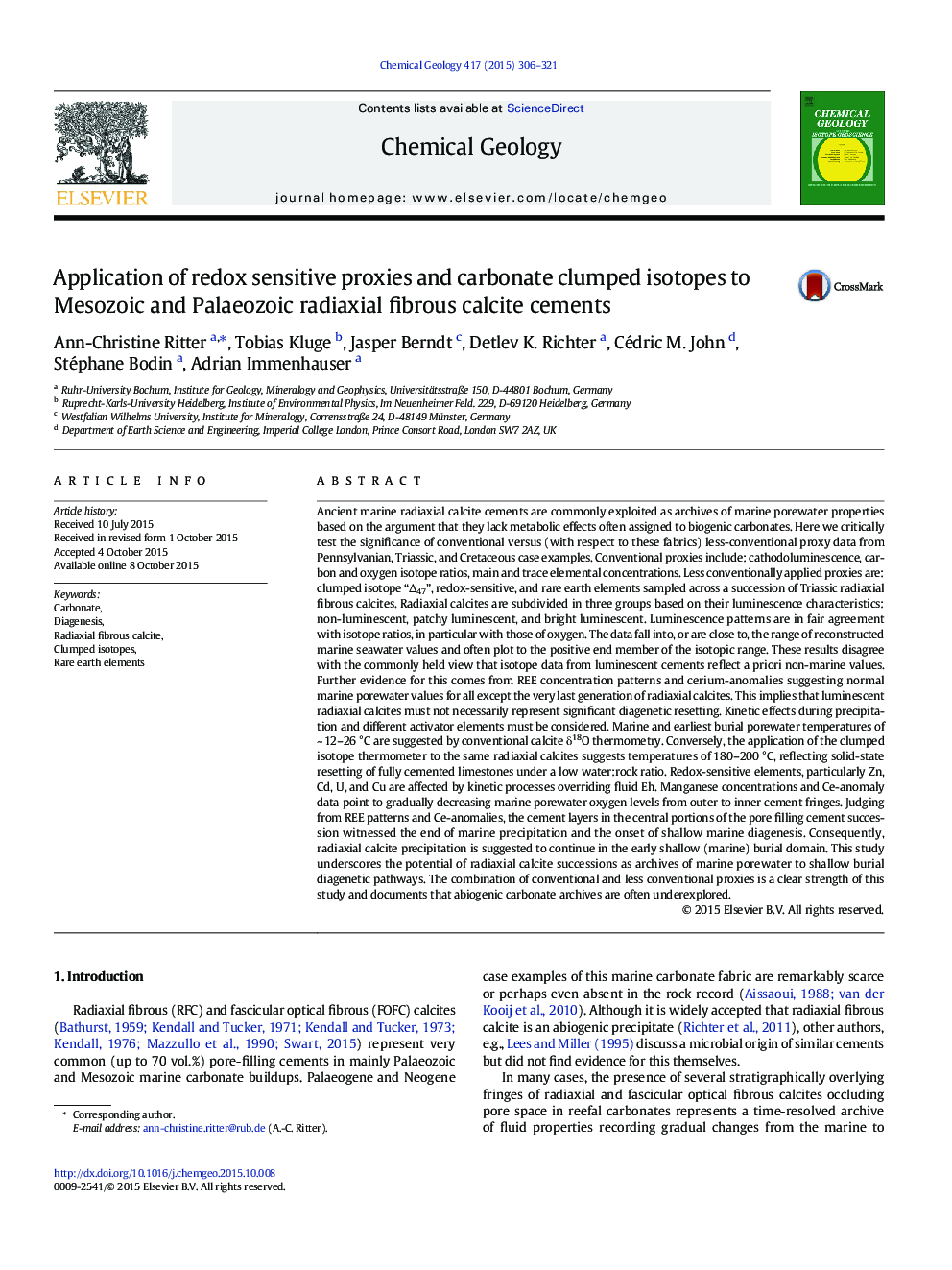| کد مقاله | کد نشریه | سال انتشار | مقاله انگلیسی | نسخه تمام متن |
|---|---|---|---|---|
| 6436283 | 1637557 | 2015 | 16 صفحه PDF | دانلود رایگان |
- Radiaxial fibrous cements of different origin have been analysed and compared.
- By applying a multi-proxy approach we gain information about porewater evolution.
- A majority of samples shows a mainly marine origin of porewaters.
- Clumped isotopes and REE yield valuable new information on the cement history.
- When analysed critically, RFC can be used as archive for past seawater properties.
Ancient marine radiaxial calcite cements are commonly exploited as archives of marine porewater properties based on the argument that they lack metabolic effects often assigned to biogenic carbonates. Here we critically test the significance of conventional versus (with respect to these fabrics) less-conventional proxy data from Pennsylvanian, Triassic, and Cretaceous case examples. Conventional proxies include: cathodoluminescence, carbon and oxygen isotope ratios, main and trace elemental concentrations. Less conventionally applied proxies are: clumped isotope “Î47”, redox-sensitive, and rare earth elements sampled across a succession of Triassic radiaxial fibrous calcites. Radiaxial calcites are subdivided in three groups based on their luminescence characteristics: non-luminescent, patchy luminescent, and bright luminescent. Luminescence patterns are in fair agreement with isotope ratios, in particular with those of oxygen. The data fall into, or are close to, the range of reconstructed marine seawater values and often plot to the positive end member of the isotopic range. These results disagree with the commonly held view that isotope data from luminescent cements reflect a priori non-marine values. Further evidence for this comes from REE concentration patterns and cerium-anomalies suggesting normal marine porewater values for all except the very last generation of radiaxial calcites. This implies that luminescent radiaxial calcites must not necessarily represent significant diagenetic resetting. Kinetic effects during precipitation and different activator elements must be considered. Marine and earliest burial porewater temperatures of ~ 12-26 °C are suggested by conventional calcite δ18O thermometry. Conversely, the application of the clumped isotope thermometer to the same radiaxial calcites suggests temperatures of 180-200 °C, reflecting solid-state resetting of fully cemented limestones under a low water:rock ratio. Redox-sensitive elements, particularly Zn, Cd, U, and Cu are affected by kinetic processes overriding fluid Eh. Manganese concentrations and Ce-anomaly data point to gradually decreasing marine porewater oxygen levels from outer to inner cement fringes. Judging from REE patterns and Ce-anomalies, the cement layers in the central portions of the pore filling cement succession witnessed the end of marine precipitation and the onset of shallow marine diagenesis. Consequently, radiaxial calcite precipitation is suggested to continue in the early shallow (marine) burial domain. This study underscores the potential of radiaxial calcite successions as archives of marine porewater to shallow burial diagenetic pathways. The combination of conventional and less conventional proxies is a clear strength of this study and documents that abiogenic carbonate archives are often underexplored.
Journal: Chemical Geology - Volume 417, 6 December 2015, Pages 306-321
